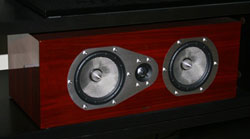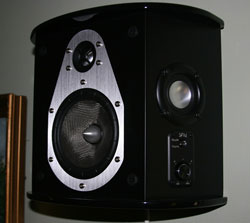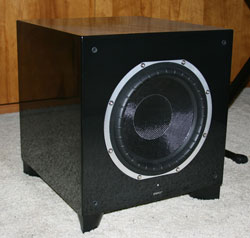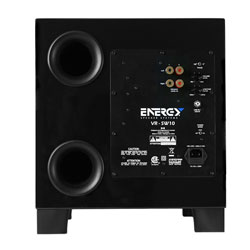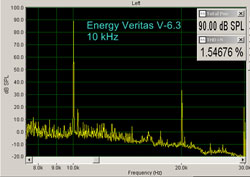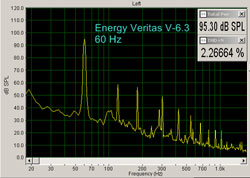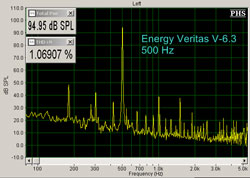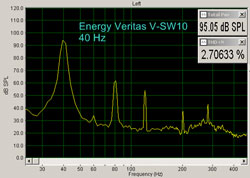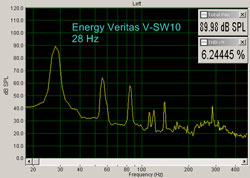Introduction to the Energy Veritas V-6.3 Speakers
Energy speakers have been around since 1973. They came into prominence with the Pro 22 and later with the Veritas v2.8 speakers which were a big hit in the mid 90’s. At an MSRP of around $6,000, the Veritas v2.8’s were known for an excellent price/performance ratio.
In recent years, Energy has become a market leader with their compact 5.1-channel satellite/sub systems. Their latest offering in this arena is the Take Classic 5.1 Home Theater System which scores very highly with the press and consumers alike.
ENERGY VERITAS V-6.3 SPEAKERS SPECIFICATIONS
Mains V-6.3 Tower Speakers
- Design: 3-way, Ported Enclosure
- Drivers: One 1″ Aluminum Dome Tweeter, One 5.25″ Kevlar Midrange, Two 6.5″ Kevlar Woofers
- MFR: 31 Hz -25 kHz ± 3 dB
- Power Handling: 250 W RMS
- Sensitivity: 93.5dB
- Nominal Impedance: 8 Ohms
- Crossover Frequency: 800 Hz, 2.5 kHz
- Dimensions: 42.5″ H x 7.75″ W x 14.1″ D
- Weight: 57 Pounds/each
- Finishes: Piano Black and Piano Rosenut
- MSRP: $1,600/each USD
Center V-5.2-C
- Design: 2-way, Ported Enclosure
- Drivers: One 1″ Aluminum Dome Tweeter, Two 5.25″ Kevlar Mid/Woofers
- MFR: 48 Hz – 25 kHz ± 3 dB
- Power Handling: 200 W RMS
- Sensitivity: 93.5 dB
- Nominal Impedance: 8 Ohms
- Crossover Frequency: 2.2kHz
- Dimensions: 7.5″ H x 19.5″ W x 9.2″ D
- Weight: 21.5 Pounds
- Finishes: Piano Black and Piano Rosenut
- MSRP: $850 USD
Surrounds V-S
- Design: 2-way, Sealed Enclosure
- Drivers: One 1″ Aluminum Dome Tweeter, Two 2″ Aluminum Dome Midrange, One 5.25″ Kevlar Woofer
- MFR: 58 Hz – 25 kHz ± 3 dB
- Power Handling: 125 W RMS / 400 W peak
- Sensitivity: 89.5 dB
- Nominal Impedance: 8 Ohms
- Crossover Frequency: 400Hz, 3 kHz
- Dimensions: 10″ H x 12″ W x 6.2″ D
- Weight: 10 Pounds/each
- Finishes: Piano Black and Piano Rosenut
- MSRP: $530/each USD
Subwoofer V-SW10
- Design: Ported Enclosure
- Driver: 10″ Fiberglass
- MFR: 23 Hz – 120 Hz ± 3 dB
- Amplifier Power: 300 watts
- Dynamic Power: 1,200 watts
- Inputs: Single Line-Level RCA Jack and Stereo Speaker Level
- Dimensions: 16.7″ H x 14.6″ W c 15.6″ D
- Weight: 40 Pounds
- Finishes: Piano Black
- MSRP: $1,100 USD
- Energy
- Secrets Tags: Speakers, Subwoofer, Tower Speakers
The system I am reviewing here is the all-new Veritas surround sound system that is based on the Veritas V-6.3. These are Energy’s largest floor standing speakers. They are mated with the V-5.2-C center, the V-S surrounds and the V-SW10 powered sub. MSRP for this entire system is just $6,210.
Design and Setup of the Energy Veritas V-6.3 Speakers
Energy’s design goal for the updated Veritas range was to address three vital sound principles:
- Flat On-Axis Frequency Response with Wide Bandwidth
- Wide and Constant Dispersion
- Low Distortion and Resonance
Here is Energy’s take on each of these points – To achieve flat on-axis frequency response, Energy uses wide bandwidth drivers with smooth roll-off characteristics that are divided by 2nd order crossover networks with frequencies selected to promote excellent driver-to-driver coherence.
In regards to a wide and constant dispersion, Energy has designed a tweeter assembly with a low resonant frequency so they could implement a lower crossover frequency between the tweeter and midrange.
Energy tackled the last design goal of low distortion and resonance by instituting tight manufacturing tolerances, solid cabinet construction and well-damped linear suspension designs. Energy also has a strict Quality Assurance program that involves testing random production samples to ensure the production units are meeting the design specifications.
The most telling feature of all Veritas speakers is the Convergent Source Module (CSM). This system provides close spacing between the tweeter and midrange in order to reduce the interaction between the two drivers. This reduced interaction means the CSM allows the drivers to act as a single source to increase dispersion. Also, the drivers’ rear chamber lowers their resonant frequencies and helps reduce distortion further.
The CSM system involves a stiffener plate between the drivers which becomes the speakers’ most obvious visual feature. And despite the optical illusion that the mids are evenly spaced on the center speaker, the tweeter is actually 1″ closer to the left mid than to the right mid.
Energy incorporates another of their important proprietary innovations in the new Veritas speakers. This is called the Ribbed Elliptical Surround Technology. Here is an explanation from the Energy website in their own words, “[The] Patented Ribbed Elliptical Surround technology (U.S. patent #6,725,967, Canadian patent #2,407,123) increases excursion, eliminates distortion and raises efficiency on our woofers and subwoofers. The Elliptical Surround encompasses the cone, allowing it to move identically in both directions, resulting in near zero distortion. And while conventional designs are often plagued with surround dimpling, which causes them to radiate in and out of phase and distort at all listening levels, our designs aren’t influenced by dimpling at all. Our proprietary Ribbed Elliptical Surrounds allow for a larger cone surface, resulting in greater efficiency. This design also lets the cone achieve greater peak to peak movement, thus allowing it to travel more than double the distance of the competition. These attributes enable our woofers and subwoofers to move incredible amounts of air, ultimately allowing them to play lower frequencies with greater bass extension and fidelity.”
The visual appeal of these speakers is very striking. They are available in two piano high-gloss finishes – black or rosenut. My review samples were rosenut and they garnered more positive comments from my house guests than almost any other speaker I have reviewed in the past couple of years. People (me included) also liked the magnetic grilles that were among the clingiest I’ve seen. In another nice touch, an Enegy logo is imprinted on the front baffles so the clean look without the grille and sans mounting hardware was about as good as it gets.
The rear speakers have some unique features as well. They have a front-firing CSM in addition to a pair of 2″ cone midranges on the sides. These drivers are switch selectable between bi-pole or di-pole operation. There is an L-Pad on the control panel that attenuates the response of the side drivers. Special keyhole wall mount hardware is included with the speakers. The mounting hardware is designed to leave ample space behind the cabinet so you can use thick gauge speaker wires to connect the rears.
Outside of its high gloss black finish, I found the V-SW10 subwoofer to be pretty basic by today’s standards. Its 10-inch fiberglass main driver is in a rear-ported cabinet and is powered by a 300 watt RMS Bash amplifier. The plate amp has line level and speaker level inputs, a variable crossover setting, a 0/180 phase switch, a level control and an On/Off/Auto selector. This sub does not have automatic room correction.
Some assembly of the main towers was required. This involved installing the plinth and the included floor spikes or rubber feet. Once I had this done, I placed the main speakers 10′ apart and 3′ away from the front wall. The center was placed on a shelf below my plasma display while the sub was placed in the front left corner of the room. I mounted the rears on the back wall and set them to bi-pole operation.
Associated equipment was my Oppo BDP 83 SE player, a Marantz AV7005 pre pro and an Emotiva XPA 5 power amp. I ran the automated Audyssey room correction and then reduced the side drivers on the rears by 2 – 3 dB before auditioning. The mains were being run full range with the center and rears crossed over at 80 Hz. All my below listening impressions were made with Audyssey room correction engaged unless otherwise noted.
The Energy Veritas V-6.3 Speakers In Use
The Energy Veritas v2.8 speakers that were so popular in the 90’s had an open and articulate sound despite a slight peak in the bass response that required deliberate set up to get the most out of the speakers. Many audiophiles were willing to experimenting with placement and system matching with the Veritases. Once they got them set up right, the payoff was a pair of speakers that represented an excellent value as an entry into the high end speaker arena.
Subsequently, Energy has had a number of intervening years to update and refine their product lines. So I was really looking forward to auditioning this speaker system in my own home. Would they live up to their pedigree by offering a high-end experience at a mid-fi price point? The answer is . . . it depends. It depends largely on whether your personal tastes, room and system match up with their frequency response characteristics.
Very few consumer speakers have perfectly flat response. Almost every speaker is voiced to some extent or another. The new Energy Veritas speakers were apparently voiced to emphasize the upper mid and lower treble. If you have warm sounding electronics or if you prefer a more forward presentation in the brilliance region, then you will just love the Veritases. If you favor a warmer sound, then they may not work for you. For my tastes, I liked these speakers much more for cinema than for music. Your mileage may vary.

So I’ll start with my listening impressions on the cinema front with the Blu-ray of Captain America: The First Avenger. In the transformation scene and the following chase scene, bullets and gunshots had a nice, crisp pop to them. The V-6.3 mains were being run full-range and they really held their own with the big explosions during first attack on Hydra.
Although this Energy system is not quite the best I’ve heard from the standpoint of surround envelopment, the surround activity did place me in the room with the actors during the pub scene. There was good spacing and air in the rears in this scene. And the movie’s finale found these speakers at their best: action-packed cinema. The Veritas V-6.3 system is dynamic, clean-sounding with excellent transient response, silent backgrounds and good depth. But the upper mid/low treble peak stopped it from sounding totally realistic (on voices in particular).

Spy Game has an awesome sound design and musical score. In DTS HD Master it is expansive with deep bass, clean treble and good dynamics. During the opening action sequence the drums were fast and powerful with a satisfying kick. The choppers in Danang were a good example of the Veritas’ abilities with movie sound – I paused the movie and looked out the window. I really thought there was a chopper hovering over my house! The front soundstage filled the space between the floor and the ceiling while the violins here were satisfyingly credible during the informant (Anne Cathcart) scene. The Veritas’s are indeed at their best with movies. They are crisp, tight, fast and clean.
I had spent a decent amount of time with the Veritas at this point. The upper-mid prominence affected natural movie sounds like voices and acoustic instruments, but it didn’t detract much from Foley effects which aren’t all that natural most of the time anyway. Some movies sounded better than others. Take Cars 2, for example. During races, the roar and whine of the different engines was easy to differentiate and many of the scenes had low level engine sounds that were highly “intelligible” and were easy to differentiate as well. Tire squeaks sounded very good too.

I watched Cars 2 with HT-EQ on. This is Marantz’s re-EQ setting that functions similar to THX re-EQ. With HT-EQ engaged, the score by Michael Giacchino was about the best musical presentation I could get through the Veritases. The music by “The Cars” near the beginning of movie sounded balanced while the organ in the “Towkyo” chase scene had just the right amount of vibrato. My only knock on the Veritas system with this movie was that the surround layering was not quite as rich as with the best systems.
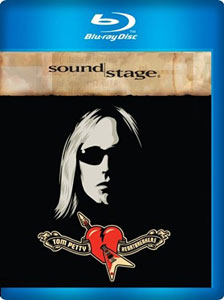
I auditioned the Veritas system with three music selections, beginning with the Blu-ray of Soundstage Presents: Tom Petty & The Heartbreakers Live. I used the fader control on my Marantz SSP to bring in more hall ambience which helped deliver a more live listening experience. Petty changed guitars on almost every track and the Veritas system revealed the differences in each. There are highlights on this disc for sure – “Melinda” gave me goosebumps while the mandolin, acoustic guitar and the roots vibe were just right on “Rollin’ in My Sweet Baby’s Arms”. And the cymbals were delicate and extended on “Lost Children”. But the Veritas’s treble made this concert sound more like a live show over a decent PA system as opposed to a live show where I was part of the action.

Another fun Blu-ray is Julieta Venegas: MTV Unplugged. This Mexican singer/songwriter is cute as a button and this disc makes me wish I were more fluent in Spanish. This “unplugged” concert features acoustic strings and a sousaphone but with an electric upright bass? I listened in 5.1 PCM.
The actual stage at the live venue was sprawling. The Veritas likewise lit up the whole room with excellent spacing between instruments. The delicate falsettos in Venegas’s vocal work were preserved over the Veritas. But on “Esta Vez” the piano, strings and sibilants in her voice were too prominent. The Veritas were generally better with dense arrangements as in the next tune, “Algún Dia”. And they were at their best with the cello on “Como Se”. These towers are legitimate full-range speakers.

I wanted to try the Veritas V-6.3 towers as a stereo pair and so I pulled out the CD of Steve Martin and the Steep Canyon Raiders: Rare Bird Alert. I turned off the Audessey EQ and listened in 2.0 stereo. I know Steve Martin is generally perceived as a comedian, but this is serious music (up until the last track anyway). This bluegrass album features guest appearances by Paul McCartney and the Dixie Chicks and is the spawn of Steve Martin’s brain for sure.
There was good bass extension on “Yellowback Fly”. The Veritases afforded the maximum spacing between notes on plucked strings which helped promote first-rate pacing. Try “Women Like to Slow Dance” if you have any doubts. That tune will get your foot tapping. I also enjoyed the harmonies in the chorus on this song as well.
When it came to music listening, the Veritas system was able to carry me over the threshold where you transition from listening over a sound system to feeling like you are sitting in on a live performance. But these transformative experiences were less frequent than I wished for. The response in the upper mids was a little too prominent for this to occur as often as I liked. Also, the sub couldn’t quite keep pace with the large V-6.3 towers. I think the Veritas V-6.3 system is a very fine system for a dedicated movie system with the occasional music listening session. Their clarity and dynamics on special effects are first-rate. Just budget enough to get two of the subs and you’ll be all set.
The Energy Veritas V-6.3 Speakers On the Bench
All the below measurements are in-room response. The frequency response tests were performed at 1-meter and the distortion measurements were on-axis near field measurements.
The on-axis frequency response is very smooth between 300 Hz up to the mid-tweeter crossover point at 2.5 kHz. Above this point, you can see the rise in response. Energy may consider a switch or LPad that the user could use to attenuate the tweeter. The bass began to roll off at around 36 Hz.
The off-axis response has a little more unevenness throughout, but with solid high frequency extension.
The 1 kHz tone produced only 1.2% THD+N at 95 dB.
This 5 kHz tone was produced by the tweeter and I measured just 1.3% THD+N at 95 dB.
At 10 kHz and 90 dB, the V-6.3’s tweeter had 1.5% THD+N.
At 40 Hz and 90 dB, the THD+N measurement was 5.6%.
At 60 Hz and 95 db, the THD+N was only 2.3%.
As usual, the 500 Hz test yielded the lowest THD+N reading with only 1.1% distortion at 95 db.
This is the in-room plot at 1m on-axis. The sub was in the corner. The sub had strong response to around 30 Hz.
At 80 Hz and 95 dB, the THD+N was 1.6%.
At 40 Hz and 95 dB, the THD+N was 2.7%.
The distortion rose to 6.2% when reproducing a 28 Hz sine wave at 90 dB.
Conclusions About the Energy Veritas V-6.3 speakers
I’d like to offer my concluding thoughts on the Energy Veritas V-06.3 system through a sort of audio report card:
| “Course” | “Grade” |
| Midrange | A |
| Bass | B |
| Treble | C+ |
| Transients/Dynamics | A+ |
| Imaging | A+ |
| Pacing | A |
| Surround Effects | B |
| Realism | C+ |
| Build Quality | A |
| Value | C+ |
I am giving the Energy Veritas V-6.3 5.1 System an overall passing grade even though their voicing did not meet with my personal tastes when it came to music. I could happily live with this system in a cinema only setting. So if you are building a movie system or if you prefer a forward treble presentation or if you have a warm sounding room, then give these a try. Their clean, immediate and open sound may be just what you want.






